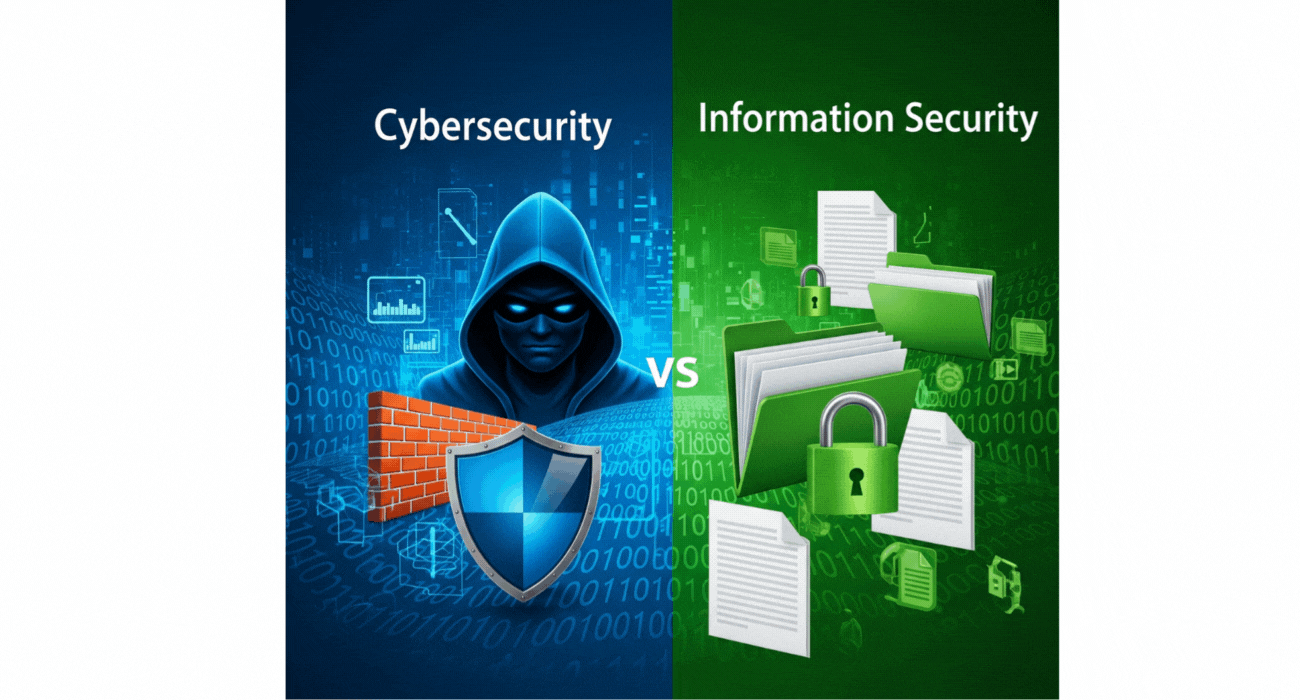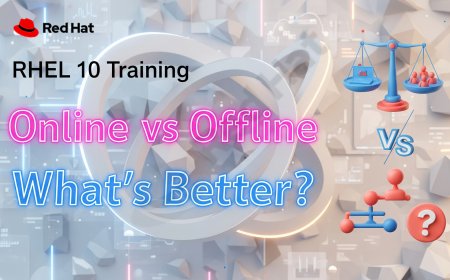Cybersecurity vs. Information Security | What’s the Difference?
In today’s digital world, terms like cybersecurity and information security are thrown around frequently, often interchangeably. But are they really the same thing? If you’ve ever wondered about the difference between these two critical fields, you’re not alone. Both are essential for protecting sensitive data and ensuring safety in an increasingly connected world, yet they have distinct focuses, methods, and goals. This blog post will break down the differences and similarities between cybersecurity and information security in a way that’s easy to understand, even if you’re new to the topic. We’ll explore their definitions, scope, tools, and real-world applications, and by the end, you’ll have a clear picture of how these fields work together to keep our data safe.

Table of Contents
- What Is Cybersecurity?
- What Is Information Security?
- Key Differences Between Cybersecurity and Information Security
- Comparison Table
- How Cybersecurity and Information Security Work Together
- Real-World Examples
- Why Understanding the Difference Matters
- Conclusion
- Frequently Asked Questions (FAQs)
What Is Cybersecurity?
Cybersecurity is all about protecting digital systems—computers, networks, servers, and devices—from cyber threats. These threats include hacking, malware, phishing, ransomware, and other attacks that aim to steal data, disrupt operations, or cause harm. Think of cybersecurity as the digital equivalent of a security guard patrolling a building, ensuring no unauthorized person gets in.
The focus of cybersecurity is on securing the digital infrastructure. This includes:
- Protecting networks from unauthorized access
- Safeguarding devices like laptops, smartphones, and IoT (Internet of Things) devices
- Preventing malicious software from infecting systems
- Ensuring secure communication over the internet
Cybersecurity professionals use tools like firewalls, antivirus software, intrusion detection systems, and encryption to keep systems safe. They also stay updated on the latest cyber threats, as hackers are constantly evolving their tactics.
What Is Information Security?
Information security, often shortened to "InfoSec," is a broader concept that focuses on protecting information itself, regardless of whether it’s stored digitally, physically, or even in someone’s mind. The goal is to ensure the confidentiality, integrity, and availability of data—often referred to as the CIA triad.
- Confidentiality: Ensuring only authorized people can access the information.
- Integrity: Keeping data accurate and unaltered.
- Availability: Making sure data is accessible to authorized users when needed.
Unlike cybersecurity, which is limited to digital environments, information security covers all forms of data, including paper records, verbal communication, and digital files. For example, locking a filing cabinet with sensitive documents or training employees not to share passwords are both part of information security.
Key Differences Between Cybersecurity and Information Security
While cybersecurity and information security overlap in many ways, their differences lie in their scope, focus, and methods. Here’s a breakdown of the key distinctions:
- Scope: Cybersecurity is a subset of information security, focusing only on digital systems and cyber threats. Information security encompasses all forms of data, including physical and digital.
- Focus: Cybersecurity is about protecting systems and networks from cyber attacks, while information security is about protecting the data itself, no matter where it’s stored.
- Threats Addressed: Cybersecurity deals with digital threats like malware and hacking. Information security also covers non-digital risks, such as theft of physical documents or insider threats.
- Tools and Methods: Cybersecurity relies heavily on technology like firewalls and encryption, while information security also includes policies, employee training, and physical security measures.
Comparison Table
| Aspect | Cybersecurity | Information Security |
|---|---|---|
| Definition | Protecting digital systems from cyber threats | Protecting data in all forms (digital, physical, etc.) |
| Scope | Digital systems and networks | All forms of data, including digital and physical |
| Primary Focus | Securing systems and preventing cyber attacks | Ensuring confidentiality, integrity, and availability of data |
| Threats Addressed | Hacking, malware, phishing, ransomware | Cyber threats, physical theft, insider threats, human error |
| Tools and Methods | Firewalls, antivirus, encryption, intrusion detection | Policies, access controls, physical security, training |
How Cybersecurity and Information Security Work Together
Cybersecurity and information security are not mutually exclusive; they complement each other. Cybersecurity protects the digital pathways that data travels through, while information security ensures the data itself remains safe and usable. For example:
- A company might use cybersecurity tools like firewalls to prevent hackers from accessing their network (cybersecurity) while also implementing strict access controls to ensure only authorized employees can view sensitive customer data (information security).
- Training employees to recognize phishing emails is part of information security, but it also strengthens cybersecurity by reducing the risk of a cyber attack succeeding.
Organizations need both to create a robust security posture. Without cybersecurity, digital systems are vulnerable to attacks. Without information security, even the most secure systems can be compromised by human error or physical breaches.
Real-World Examples
Let’s look at some practical scenarios to see how cybersecurity and information security play out in real life:
- Scenario 1: A Data Breach at a Retail Company
A hacker exploits a weak password to access a retail company’s customer database. This is a cybersecurity failure because the network wasn’t properly protected. However, if the company had encrypted the customer data (an information security measure), the stolen data might be useless to the hacker. - Scenario 2: Lost Paper Records
An employee leaves a folder of sensitive client contracts in a coffee shop. This is an information security issue, as it involves physical data loss, not a digital attack. Cybersecurity wouldn’t help here, but information security policies, like requiring secure storage for physical documents, could prevent this. - Scenario 3: Phishing Attack
An employee clicks a malicious link in a phishing email, installing malware on their computer. This is a cybersecurity issue (malware infection) but also an information security problem (lack of employee training on recognizing phishing attempts).
Why Understanding the Difference Matters
Knowing the difference between cybersecurity and information security helps organizations and individuals prioritize their security efforts. For businesses, it means building a comprehensive security strategy that covers both digital and non-digital risks. For individuals, it’s about understanding that protecting your data involves more than just installing antivirus software—it also means being cautious about sharing sensitive information and securing physical documents.
By recognizing the unique roles of cybersecurity and information security, you can make informed decisions about the tools, policies, and practices needed to stay safe in a world where data is a valuable asset.
Conclusion
Cybersecurity and information security are two sides of the same coin, both working to protect our data in an increasingly complex world. Cybersecurity focuses on defending digital systems from cyber threats, while information security takes a broader approach, safeguarding data in all its forms—digital, physical, or otherwise. Together, they form a comprehensive defense against the many risks we face today.
By understanding their differences and how they complement each other, organizations and individuals can build stronger, more effective security strategies. Whether you’re a business owner, an IT professional, or just someone trying to keep their personal data safe, knowing the distinction between these fields empowers you to take the right steps toward protection.
Frequently Asked Questions (FAQs)
What is the main difference between cybersecurity and information security?
Cybersecurity protects digital systems from cyber threats, while information security safeguards data in all forms, including digital and physical.
Is cybersecurity a part of information security?
Yes, cybersecurity is a subset of information security, focusing specifically on digital threats.
What is the CIA triad in information security?
The CIA triad stands for Confidentiality, Integrity, and Availability, which are the core principles of information security.
What are common cybersecurity threats?
Common threats include hacking, malware, phishing, ransomware, and denial-of-service (DoS) attacks.
What are examples of information security measures?
Examples include access controls, encryption, employee training, and securing physical documents.
Can you have cybersecurity without information security?
Not effectively. Cybersecurity protects digital systems, but without information security policies, data can still be compromised through non-digital means.
Why is encryption important in both fields?
Encryption protects data by making it unreadable to unauthorized users, ensuring confidentiality in both cybersecurity and information security.
Do small businesses need both cybersecurity and information security?
Yes, both are essential to protect digital systems and sensitive data, regardless of business size.
What is a firewall in cybersecurity?
A firewall is a security tool that monitors and controls network traffic to prevent unauthorized access.
How does employee training relate to information security?
Training helps employees recognize threats like phishing and follow secure practices, reducing the risk of data breaches.
Can physical security be part of information security?
Yes, securing physical documents and devices is a key aspect of information security.
What is malware?
Malware is malicious software designed to harm or exploit digital systems, such as viruses or ransomware.
How do cybersecurity and information security overlap?
Both aim to protect data, with cybersecurity focusing on digital threats and information security covering all data forms.
What is phishing, and how does it relate to both fields?
Phishing is a cyber attack that tricks users into sharing sensitive information, requiring both cybersecurity defenses and information security training to prevent.
Are passwords part of cybersecurity or information security?
Passwords are part of both—cybersecurity uses them to secure digital systems, while information security ensures they’re managed safely.
What is two-factor authentication (2FA)?
2FA adds an extra layer of security by requiring two forms of identification, enhancing both cybersecurity and information security.
Can information security prevent insider threats?
Yes, policies like access controls and monitoring can reduce the risk of insider threats.
What role does encryption play in cybersecurity?
Encryption secures data transmitted over networks, preventing hackers from intercepting it.
Why is regular software updating important?
Updates patch security vulnerabilities, strengthening cybersecurity defenses.
Can an organization rely solely on cybersecurity?
No, relying only on cybersecurity leaves non-digital data vulnerable, requiring information security measures.
What is a data breach?
A data breach is the unauthorized access or theft of sensitive information, often due to cybersecurity or information security failures.
How can individuals practice information security?
Use strong passwords, lock physical documents, avoid sharing sensitive information, and stay cautious online.
What is a VPN, and how does it help?
A Virtual Private Network (VPN) encrypts internet connections, enhancing cybersecurity for remote access.
Do cybersecurity and information security apply to personal devices?
Yes, both are crucial for protecting personal devices and data from digital and non-digital threats.
How often should security policies be updated?
Security policies should be reviewed and updated regularly, at least annually or after significant changes.
What's Your Reaction?
 Like
0
Like
0
 Dislike
0
Dislike
0
 Love
0
Love
0
 Funny
0
Funny
0
 Angry
0
Angry
0
 Sad
0
Sad
0
 Wow
0
Wow
0








![How to Install RHEL 10 on VMware/VirtualBox [Tutorial]](https://www.cybersecurityinstitute.in/blog/uploads/images/202509/image_430x256_68b56dc967a4a.jpg)







